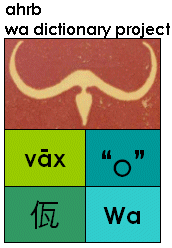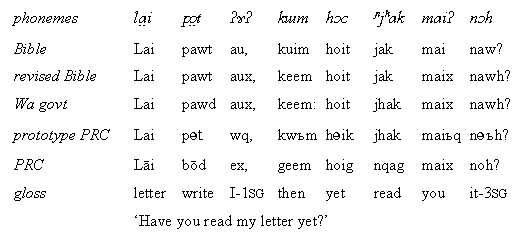
|
Writing of the Wa LanguageUpdated 2006-07-30BackgroundThere are several alternative transcriptions or orthographies in use for spelling the sounds of Wa. The first was established by the 1938 publication of the Wa translation of the New Testament of The Bible by M. Vincent Young, Sara Yaw Shu Chin (95 years old in 2006 and living in Lashio, Myanmar), and other Wa-speaking translators. We refer to this as the "Bible orthography," "old Bible orthography," or "x-wa-sara." In Chinese it is usually called lǎowǎwén 老佤文 "old Wa orthography" or sālāwén 萨拉文 "missionary orthography." This orthography, and variations of it, are still commonly used today, especially in Myanmar (Burma) and among Wa Christians. Both because of its historical significance and enduring currency, it must be reckoned with in our dictionary, in its current revised form (see below), alongside other orthographies, and can be generated through an automatic conversion. Chinese orthographyIn the 1950s in the People's Republic of China (PRC), a scientifically-based orthography was proposed and put into limited use. Like the older Bible orthography, it used the characters of the Roman alphabet, but also made use of one or two Cyrillic characters. It was designed to coincide as much as possible with the then new pinyin romanisation of Chinese characters. Today, a revised, purely-Roman, version of this orthography is now the one used in official publications in China. A few dozen books have been published using it, almost all by the Yunnan Nationalities Publishing House (Yunnan Minzu Chubanshe 云南民族出版社), with an extremely limited audience of fewer than 100 people --not much more than the coterie of translators, editors, and literary bureaucrats themselves. We refer to this as the "Chinese orthography," "PRC orthography", "Wa-CN," or, by strict ISO standards, "x-wa-CN", i.e., the Wa language (x-wa) as used and written in China (CN). In Chinese it is known as xīnwǎwén 新佤文, or "new Wa orthography." One distinctive visual feature of the Chinese orthography is its use of final -x to represent a final glottal stop -- subsequently adopted in other orthographies. Another signature trait is the use of nasal+stop consonant-cluster syllable initials such as "nd-", "nj-", "nb-", and "mg-" to represent voiced unaspirated stop initials, and "nt-", "nq-", "np-", and "nk-" to represent voiced aspirated stop initials. These spellings were necessitated by the design requirement of consonance with pinyin (since Modern Standard Chinese lacks voiced initials and the pairs "b-/p-","d-/t-", and "g-/k-" represent a contrast in aspiration). Mastering these nasal+stop consonant-cluster syllable initials is probably the biggest challenge to all Wa speakers in China in achieving literacy in their native language. And as a result of using initial "n-" (or "m-") to represent voicing, about one-sixth of all words in Wa Chinese orthography begin with the letter "n". In many words beginning with "n-", "m-", and "h-" (used to mark some aspirated initial-stop consonants), the initial letter of a syllable reveals nothing of its pronunciation other than voicing or aspiration. Thus it is impractical to use initial letters as abbreviations in Wa Chinese orthography, as in other Roman-script languages. Breathy (or lax) register in syllables is indicated by a macron (bar) over the first vowel in the syllable. However, numerous publications have dispensed with the use of macrons entirely. Myanmar-based orthographiesMeanwhile, several revisions and improvements to the original Bible orthography have also been proposed. Among these "revised Bible orthographies" is one used in the 1990s in publications of the Wa Welfare Society (WWS) in Chiangmai, Thailand. It has been developed further by the Wa authorities in Pang Kham (Pang Hsang), Wa Special Region 2, in a series of literacy primers for use by the troops in the United Wa State Army (UWSA). We refer to this orthography as "Myanmar orthography," "Revised Bible orthography," "Wa government orthography," "Wa-MM," or "x-wa-MM," i.e., the Wa language (x-wa) as used and written in Myanmar (MM). It is sometimes called in Chinese shànwǎwén 善佤文, or "improved missionary orthography" (with a perhaps unintended double entendre with 掸佤文 "Shan [State] orthography"). It is also used by a dedicated development organization, Sipeem Tawx Bwan:, founded by Marcus Young, who is the grandson of M. Vincent Young. Sipeem Tawx Bwan: (STB) works with Wa-speaking people, and is based in Mae Sai, northern Thailand. All the revised Bible orthographies represent the phonological distinctions
of Wa more accurately than the original Bible orthography. They also
adopt from the Chinese orthography the use of -x to represent a final
glottal stop. One signature contrast with the Chinese orthography, however,
is the continued use of "aw" for the common half-open back rounded vowel
(IPA ɔ [ The various versions of Wa Bible orthography have been used to publish a dozen or so titles in Myanmar and Thailand in the last twenty years. The bulk of these are Bible-related and Christian in inspiration and the reading audience is in turn predominantly Christian, numbering perhaps a few thousand--a much larger number than for texts in Chinese Wa orthography. A handful of published texts are Buddhist or secular in content, with an unknown readership. So there is the irony that on the Chinese side of the border there is an abundance of titles and content in Chinese orthography and paucity of readers, while on the Myanmar side of the border there is a much more restricted variety of content available in Myanmar orthography, with a many-times larger, but still small, potential readership. The differences in look and feel between the orthographic systems is apparent from the comparison
below of the sentence in Wa 'Have you read my letter yet?'.
There are sample texts using each orthography on the Wa Corpus page. Unified Wa orthographyWe also have a page describing our experimental Unified Wa orthography, which synthesises a normalised version of the syllable-initial consonantal system of the Myanmar orthography with the syllable-final vowel and suprasegmental system of the Chinese orthography. One possible application for Unified Wa orthography will be to reissue the entire digital library of texts in Wa on CD in a single consistent, normalised form, which will be convertible to other orthographies via the automatic Wa Orthography Converter. Serial arrangementThe Chinese orthography, based on the precedent of Chinese pinyin, is arranged in the dictionary using the familiar a-b-c alphabetical order. The Myanmar orthography can also be arranged alphabetically, although the specific order of words is quite different from that of the Chinese orthography. But the Wa authorities in Pang Kham (Pang Hsang) present the Roman letters in a phonetically logical matrix, in the style of Indic scripts. A serial order can be tentatively constructed on the basis of the matrices for 58 syllable-initial consonants and consonant clusters, 26 nuclear vowels and polyphthongs, and 16 final consonants, as shown in the table belowː
*New since August 2005's 1st serialising of Wadict DB.
**New since late September 2005's 2nd serialising of Wadict DB.
When this order is applied to entries in the Wa dictionary, it looks like this small sample of Wa-MM entries in Indic order. Charts and conversion toolsFor specific characters and their phonetic values, see the Comparative Chart of Wa Orthographies; the Correspondence List of Wa-CN Orthography and International Phonetic Alphabet (IPA) (from Loux Gāb Vax 佤语熟语汇释, by Wang Jingliu 王敬骝 et al., pp. 461-462); or the more comprehensive chart, Comparative Chart of Wa Orthographies organized by syllable initials and finals. There is also a Comprehensive Comparative Chart of Wa Orthographies. However, this may overtax your browser, since it is a large 525KB, 16,000-line file containing every conceivable syllable in Wa. If you have difficulty viewing it, you may do better by downloading it to your hard drive (right-click of the mouse in Windows) and open it in a plain-text editor or word-processor which supports Unicode, such as the Windows Notepad, Macintosh OSX TextEdit, or MS Word for Windows. The file is in Unicode UTF-8 format. To see the IPA characters as well, as noted in our fonts and character display section, you will need a Unicode font which contains IPA characters. You can also try out the on-line automatic Wa Orthography Converter on our Interactive Tools Page. The converter can also be used to convert files when run from a command prompt (a local Perl interpreter such as ActiveState ActivePerl is required). ConclusionIn summary, the Chinese orthography and the Myanmar (revised Bible) orthography, in its principal post-2000 variations, are included in the Wa dictionary database, alongside a phonetic transcription using the International Phonetic Alphabet (IPA). The final printed dictionary will also include at least a cross-index for looking up entries in the original Bible orthography. |
 ]
), whereas the Chinese orthography uses "o". Another recent innovation
and signature contrast is the use of a colon ( : ) after many syllables
to mark them as clear (non-breathy) or tense register syllables (i.e.,
those syllables which do not have a macron over the
first vowel in the Chinese orthography). The revised Bible orthographies,
like International Phonetic Alphabet, use initial "b-", "d-", and "g-" for
voiced stops, while in the Chinese orthography, these represent unvoiced
unaspirated initial stops, as they do in Chinese pinyin romanisation.
]
), whereas the Chinese orthography uses "o". Another recent innovation
and signature contrast is the use of a colon ( : ) after many syllables
to mark them as clear (non-breathy) or tense register syllables (i.e.,
those syllables which do not have a macron over the
first vowel in the Chinese orthography). The revised Bible orthographies,
like International Phonetic Alphabet, use initial "b-", "d-", and "g-" for
voiced stops, while in the Chinese orthography, these represent unvoiced
unaspirated initial stops, as they do in Chinese pinyin romanisation.

